#and that there are bystander awareness during instances of in-fighting
Explore tagged Tumblr posts
Text
While im thankful for tumblr sharing a lot of good posts relating to Mandrillus sphinx. I’m getting a bit tired of seeing angry looking male mandrills or mandrills with opening their mouths (and showing off their large canines) that I’m very much tempted to create a long as science post dedicated to research on Mandrill post-conflict behavior.
Mandrills are more than just sexually dimorphic or in constant competition against one another!!
#maybe i just wanna see some sweet and sentimental art or photos or writing about mandrills that show off their interests and care for their#troop/horde members?#like they use physical closeness in space from one another /timed eye contact#and grooming techniques#and that there are bystander awareness during instances of in-fighting#and they try to find a way to lower the stress by finding post-conflict strategies
0 notes
Text
“Or Are You On My Side?”
Betrayal, Choices, & Blame
— an analysis | theory

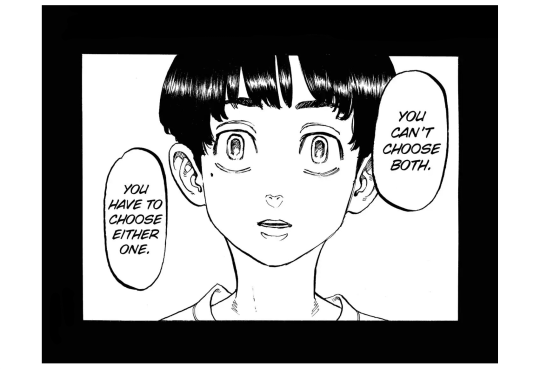
under the cut!
From a young age, Kazutora has been conditioned to think in black and white. Having to choose which parents to side with, he wasn’t allowed to have both, neither, nor to find the grey area within. He was given no other choices than what was picked for him, an illusion of choice. The fight between his mother and father involved him, a bystander to their conflict, to become a victim to their neglectfulness. He felt hurt and betrayed by how they treated him or rather, their lack of treatment towards him. Kazutora even describes his home as cold and never a warm environment. This mindset grows up with him— always popping up in his thoughts when interacting with others.
He asks the questions, who will betray me next? Who can hurt me next?
This is the start of a code he creates for himself, a mantra repeated through his thoughts as he develops, but never reversed as he doesn't reflect within himself.
As a victim between the fights and abuse, he carries that mentality with him growing up; as a defensive approach to others. With Kazutora, the thought of betrayal festered. Of others having potential to hurt him. He was suffering with these thoughts, never letting others in. With this fear buried in his mind, he still attempted to reach out for friends with hope that things would be better with them compared to his parents. And they were, for a time.
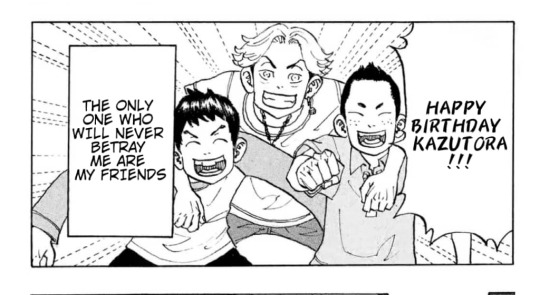
For Kazutora’s birthday, his friends take him to an arcade to have fun, only to make him pay for it instead. It’s mentioned that this happens often when his friend Junpeke apologizes for always asking him to pay. Kazutora’s mood turns slightly depressed when reminded of that fact just after saying how much he likes being with them, and how they help him forget his anxiety. On the inside, he knows the truth but won’t admit that he’s being used until pushed by someone else.
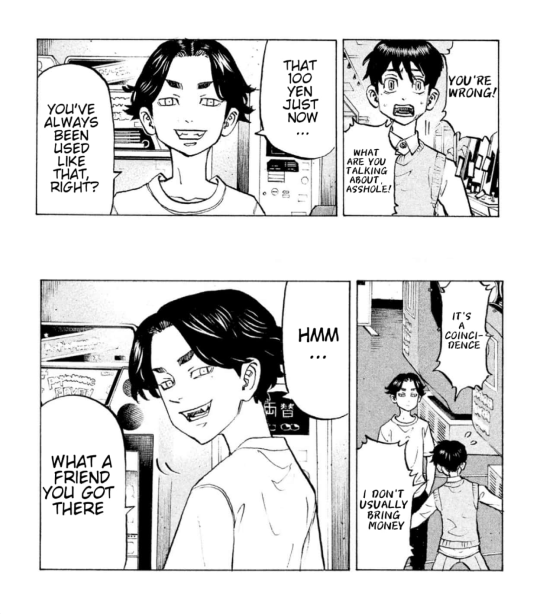
That's where Baji comes in, who he meets for the first time. He points out the fault within the group, that they don’t see Kazutora as a friend but as a money tree instead. That they only saw him as something— someone— to be used when it helped them out. They ran away leaving Kazutora alone to fend for himself. Again, he was the one being hurt by those around him.
After fighting with Baji on his own, in the end he admits that he has always seen himself as a money tree as well— disappointed that he’s been betrayed by them and left behind, even though he was aware it was bound to happen— he wanted to believe, but his hopes were betrayed.
“Having friends isn’t about who takes advantage. From now and onwards, you and I are... Friends.” - Baji
After finding out it was Kazutora’s birthday, Baji goes ahead to make up for the sorry excuse of friends and celebration he had. He declares himself as Kazutora’s friend, goes to burn a car together, encourages Kazutora to beat up Junpeke to feel better, gives him a piercing for the earring, and later introduces Kazutora to the rest of his friends; the future founding members of Toman.
During all this, the side story shows how Baji pulled Kazutora along and made choices for him so he wouldn’t have to, and helped encourage Kazutora to act how he wanted, even if they were bad choices. To be free from the confines he made himself and to become more confident with what he wants to do.
One day on a ride, Kazutora gets lost in his memories— of his father telling him to be thankful to whoever made him live without inconvenience. The father refers to himself here but to Kazutora, the one he is most thankful towards and respects is Baji. While the one that reminds him of his father is Mikey with his arrogance, inconsiderate of others feelings, and how it feels like he looks down on others. To be gazed down on like an ant.
He runs into his father again who traumatizes him and is rescued by Mikey, who declares himself as Kazutora’s friend. In this instance, there’s a drastic comparison in how others choose to be Kazutora’s friend.

Junpeke only said it himself when it was convenient for him, but Mikey said it when it would inconvenience him and get him in trouble.
Still, after the events, Kazutora goes to cut himself off from them; a way to ensure he will never be hurt or to involve them with his own troubles.
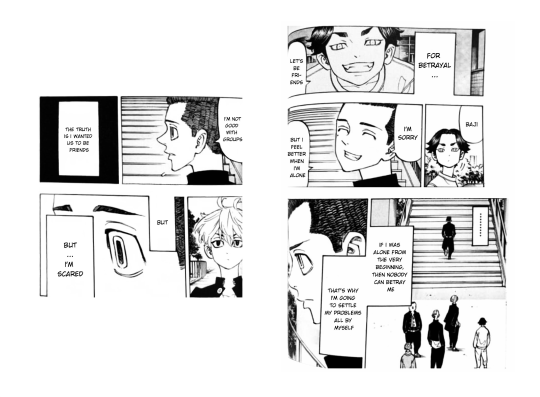
He goes to distance himself from them as he learns that friends can betray him too, not just his own parents. Kazutora thinks it's best to deal with it all on his own and to not inconvenience/burden others. He keeps them at a distance, to not let them in. That way he can never be hurt.
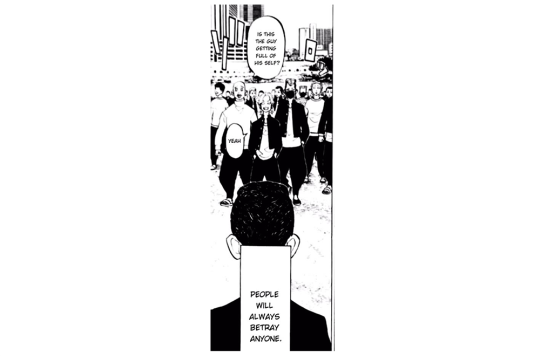
"People will always betray anyone. Be it father, mother, or friends. Every single one of them are idiots." - Kazutora
From that point on, Kazutora's thoughts changed from,"The only one who will never betray me are my friends." To, "People can betray anyone." His fear has been confirmed, and that mantra begins to haunt him.
Kazutora reflects on this, he considered his friend Junpeke a betrayer, but never considered how his actions at retaliation for the first time built up to Junpeke coming back for his own revenge. Kazutora considers this as revenge for himself, yet Junpeke also sees it as revenge for Kazutora beating him up in the past. There is no grey area considered that both are in the wrong. His world is still in black and white.
What's interesting to note is also how Kazutora always looked on from a perspective that others would betray him. That he was exempt from that. He's an outsider to his own views, there's a disconnect. It was always how others would harm him and not that he could harm others, him retaliating was his own form of 'justice'. After all, he was always the victim since a young age— the decisions he makes whether he sees it as good or bad still ends up hurting him, so he remains a victim in his mindset.
He can't handle the consequences of his own actions and doesn't want to perceive himself as being able to hurt or betray friends, like how others have done unto him. Mikey eases him of this worry.
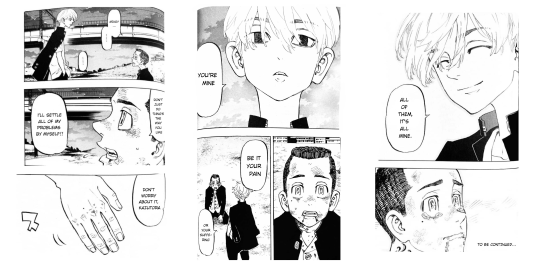
This scene itself caused a shift within Kazutora’s mind. Mikey had no idea that the power of his words took a hold within Kazutora. The words that saved him and cursed their relationship. From Mikey's perspective, it was him saying he accepted Kazutora for who he was and that they'll face his troubles together. To not keep his worries to himself and depend on one another, because they're friends.
Everything that is Kazutora's is also Mikey's.
To Kazutora with a victim complex, Mikey was his saving grace. Kazutora placed Mikey as his as well— in a sense that all his troubles and faults would be Mikey's. Kazutora was free from burdens to act as he wanted, as Mikey would take responsibility for him and his actions.
This is what led him to blame Mikey in a very convoluted sense.
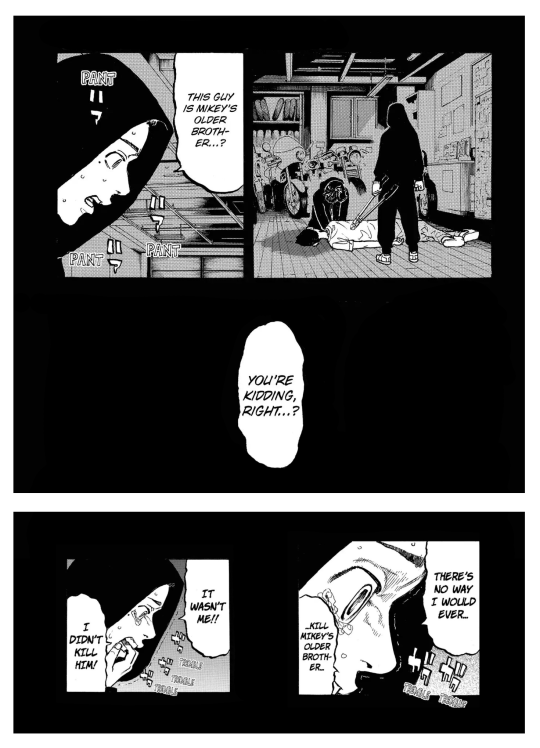
In the side stories and flashbacks, Kazutora is fine hurting and threatening others that he considers rivals and enemies— he shows no remorse. But in the panels above, he cannot accept that reality anymore, considering that he killed someone close to his friend— indirectly hurting Mikey.
He doesn't want to accept that he betrayed Mikey. He didn't want to think himself capable of hurting those close to him.
Then he remembers.
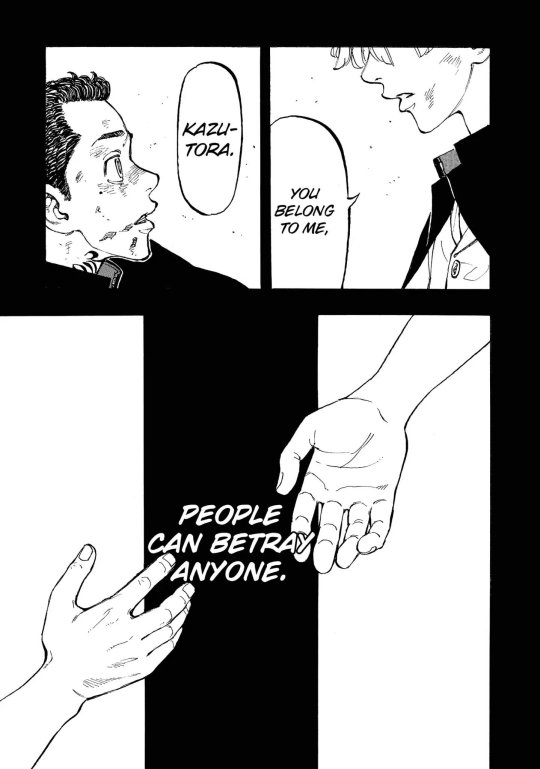
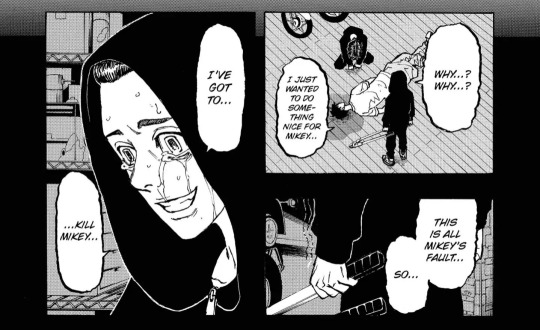
He only remembers how Mikey said all of Kazutora's problems, thoughts, himself— would be his. Through those words, Kazutora places Mikey as his Jungian shadow. He separates that entity and all of his problems from himself onto one singular person.
For Kazutora, it was all for Mikey in the first place. It was all because of Mikey. So he should shoulder the blame for everything. Kazutora doesn't want to recognize himself as a bad person like his parents or those who hurt him.
“It’s your fault I got sent to juvie.” - Kazutora
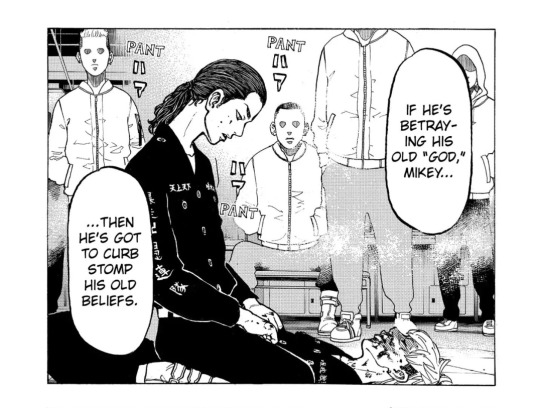
At the Valhalla initiation, the words chosen here by Kazutora as he explains the process to Takemichi is also interesting. As this is how Kazutora viewed Mikey before— when he put him on a pedestal, only to end up hurting himself and Mikey. Idolization does more harm than good. It shows that this might be how he still perceives him as well, he wants to kill off his beliefs and Mikey, but he’s also scared of Mikey and the power he holds over him still.
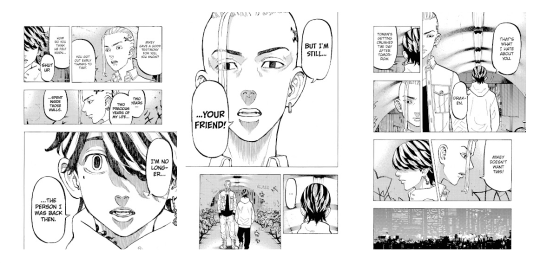
“Chifuyu... What have I told you over and over? Don’t trust anybody but your friends.” - Baji
Back when Draken tells Kazutora that they're still friends, Kazutora responds with "that's what I hate about you." Baji probably told him to trust no one but his friends as well. At this point Kazutora still trusts in the fact that Baji won't 'betray' him— so when Draken declares himself as his friend no matter the events of the past, Kazutora doesn't want to accept that fact. He wants to see in black and white, to have clear cut definitions that are easy to place as what can hurt him and what can't hurt him.
Draken is from a group that hurt him, he can't imagine himself going back to that when events could repeat again. At this moment, the fact that there's a gray area in-between the black and white does not exist to him. He doesn't want to blend the two together when it still has the possibility to harm him, so Kazutora would rather throw it away than to trust again.
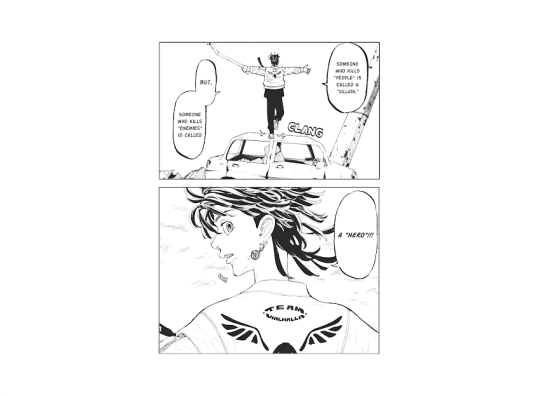
This is how Kazutora tries to translate his worldview to the others, albeit childishly. It's how he can see redemption for himself while everyone views him as a villain for killing Shinichiro. Mikey, his enemy, is a problem that he made himself. If he can get rid of that problem, a shadow that he made— then he can become his own hero, and all his problems will disappear.
With Valhalla, a gang who accepted his ideals and encouraged it— Kazutora was flying high on his emotions, feeling that it was the right thing to do, that he could be a hero and gain positive recognition from it. No one could harm him ever again, he would be too high up for others to even touch. Not even his old friends.
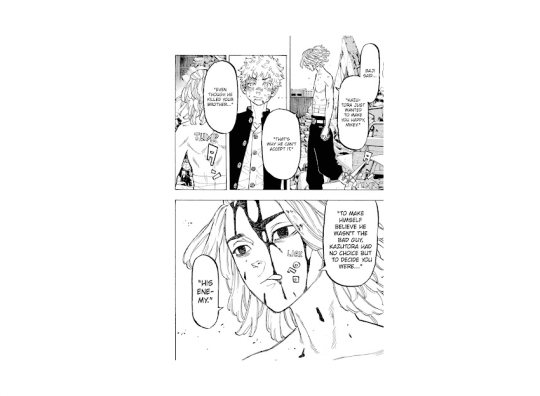
Baji did understand Kazutora to an extent but he didn't understand how to help him. Instead he accepted Kazutora's self-destructiveness and encouraged him, thinking that as long as Kazutora felt someone was on his side, he would be fine. But as incidents unfolded, Kazutora was too far gone into himself and needed a push to bring his mind back into clarity.
Baji didn't want Mikey blaming Kazutora, or Kazutora ending up blaming himself for his death, so he took it upon himself and decided it would be his own fault for dying.
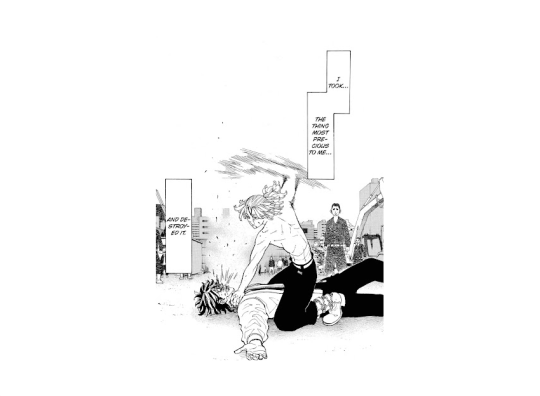
After Baji dies, Kazutora realizes that he was his own enemy and that Baji never did leave him, nor did Toman. He only betrayed himself in the end, ruining and pushing away the good things he did have. Rejecting others who tried to stop or even reconnect with him.
In the end he faces the truth, and realizes that he was also part of the problem— that it's not just others that can betray him, but also himself.
"I'm staying Baji. You guys go on… This is my fault. I want to take responsibility. I won't ask you to forgive me. I'll live my whole life with Shinichiro-kun… and Baji's deaths… on my shoulders." - Kazutora
Later, after the events of Bloody Halloween, Draken goes with Takemichi to visit Kazutora in juvie and to pass on a message from Mikey.
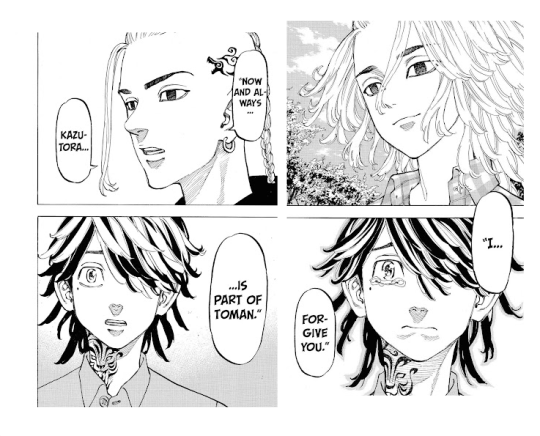
They knew that these words were important for Kazutora to hear— for his sense of self and his feelings of belonging. He's been struggling all his life with a mindset made to protect himself. That there was no one else on his side, or that there was nothing he could ever truly be a part of— without worrying how things could end up hurting him.
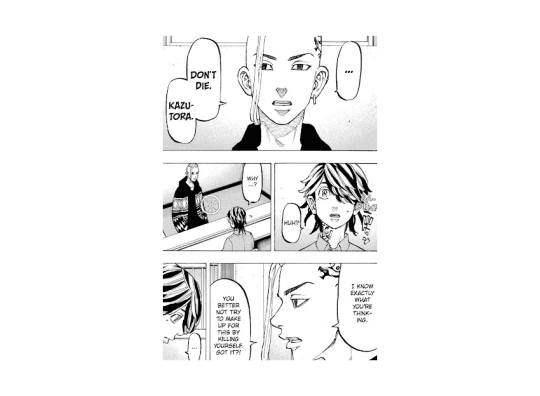
"Why…?"
He's been forgiven by Mikey and in essence of that, Toman. Kazutora though, doesn't seem to quite forgive himself yet and Draken understands some part of that. He is aware that he caused problems too and can no longer blame others for his own faults. He has no one else to share it with.
Black and white, choosing a hero and a villain. He understands he is not completely good and that no one is completely evil, but gray.
Mikey is no longer a shadow for Kazutora to push his faults onto as he has come to accept and take responsibility for the trouble he has caused. He is back to holding onto his own burdens/shadow— for himself to handle. He just has to learn how to carry it right this time.
____________

He is used to being betrayed but he doesn't think he's capable of betraying others. When he kills Shinichiro he realizes that he betrayed Mikey, it went against all reasoning that he built up, that he could do no wrong. He broke one of the stable points in his mind and the cause of him breaking his own code, was the cause of his own betrayal —> Mikey
TLDR:::
In the side stories it shows that he is used to being used and having shitty friends but doesn't want to confront it bc they're all he has.
And then in the Valhalla fight when Kisaki calls Hanma and they mention Baji betrayed them Kazutora loses it and goes to stab Baji because that was the person he least expected to betray him. Baji saved him when he was younger and made his life better and to know the person he depends and relies on broke the code? His last stable pillar? Goodbye to kazutoras mental health.
#Tokyo Revengers#kazutora hanemiya#kazutora#i really dont like the manga ending explanation like oh it was the magical power of the darkness that made him be a weird boy#i think even without the darkness he was gonna snap at one point#manjiro sano#kazutora analysis#tkrv meta#tokyo revengers meta#muuthoughts
52 notes
·
View notes
Note
If you're still doing the DVD commentary thing, I'm curious about your thought process behind the whole discussion they have in the car at the end of chapter 11, when Richie asks Eddie why he thinks It targeted them specifically.
Oh boy, this answer’s a bit depressing.
See, I’ve gotten a lot of responses talking about how much they love Went and Maggie in Indelicate. And while they are fun--and a lot of their dynamic is influenced by my own parents and grandparents, and I decided to write their behavior as sort of blueprints for Richie and his behavior towards Eddie--Richie is more upset than he lets on about their conversation about Henry Bowers and his childhood.
So in Chapter 10, I have Richie sort of pick a fight with his parents. Eddie gives him an opening, and Richie immediately seizes onto the topic of Henry Bowers and his childhood bullying, because he wants to confront his parents. About their choice to live in Derry? Maybe. About their failure to respond appropriately to some very violent childhood bullying? Definitely. Richie brings up the incident from the book where Bowers wipes out in front of their class and Richie automatically and without thinking goes, “Hey, Bananaheels!” and Bowers chases Richie all the way through Freese’s department store with his cronies, intending to beat him. Because movie!Richie wears the Freese’s shirt, I decided to keep that incident.
And Went’s immediate response to Richie’s story of “Remember when I was in great fear of physical violence and very real fear for my safety?” is to ask, “Well, what did you do to make him angry?”
I don’t know if you’ve read Things That Happen After Beverly Leaves, but in that fic I have Bev and Richie have a conversation about Tom Rogan and a specific incident of violence that happens during the fic, during which Bev asserts that it was her fault that he went after her because she was antagonizing him. And Richie’s response is something to the effect of, “Oh, really? Does everyone have that threshold? What do you have to say to me before I decide to beat you, then?” Because it’s bullshit and victim blaming, and everyone has a choice of whether or not to commit violence, especially in positions of power. (Even when the violence is committed in self-defense, there’s always the choice to--not defend yourself, and to accept those consequences. In this instance, I’m not describing “violence” as an umbrella “this is always bad” sort of thing; but I do think that it’s always bad when enacted on someone else for the purpose of harming them, especially from a position of power to someone weaker.)
Like many readers of IT by Stephen King, I was horrified by the blasé approach that most of the adults have to the childhood bullying portrayed in the book. I know that King experienced bullying as a child--probably part of why he writes it so elaborately and brutally; and I know that one of It’s influences is that It exaggerates the negative and harmful tendencies of all of Derry’s residents, including bullies like Henry Bowers (even before It interferes with him directly), Alvin Marsh and Sonia Kaspbrak (whose “protective” and abusive natures become exaggerated and inhuman), and adults who turn blind eyes to the violence happening in front of them (the older couple who saw Bowers cutting Ben and drove on, bystanders who saw Alvin Marsh chasing Bev through the street and did nothing, a shopkeeper who tried to intervene in an act of bullying and allowed Bowers and his gang to run him off instead of rescuing the Loser in question, though I’m afraid I don’t remember the specifics).
In this case, I decided that the Toziers didn’t respond appropriately to defend their son. You can decide whether that was because of Derry and It or because of their parenting style. But in this case I decided to have Wentworth demand that Richie take responsibility for his victimization. And Richie gives a sort of Stepford smile when he admits to provoking Bowers; and Wentworth’s response is “You’re very smart, but you kept being stupid and getting into fights.”
If you read the Bananaheels scene from IT, we see that Richie has literally no brain-to-mouth filter. The very second the words are out of his mouth, he wants to kick himself, but he knows Bowers will do it for him. I also write Richie as having untreated ADHD, especially as a child, and his failure to consider cause and effect here is influenced by my own brother. He literally could not consider the consequences of his temper tantrums when he was a child, because there was no reflection or consideration of cause and effect for him. Many child psychologists, psychiatrists, and therapists attested to this. Because this is a real person and someone I have great affection for, I’m not interested in breaking down whether that’s an element of being a child (it was not in my experience) or an element of having untreated ADHD (again, it was not in my experience, as I suffered crippling overthink and decision paralysis at the other end of the spectrum). But I did decide to let that influence Richie.
Eddie is very uncomfortable with Richie’s parents’ lack of sympathy, especially because he shared the experience with Richie; but he’s also uncomfortable with parents in general and very aware that he’s in the Toziers’ space and doesn’t feel he has standing towards them. Richie gets more defensive, Stepford smiling, and recounts other stories of Bowers’ gang harassing the Losers, getting crueler and more flippant both with himself and with his friends (he casually insults Ben), and culminates in the story of Bowers cutting Ben for the crime of not allowing him to cheat off him in school, something that Richie is sure the Toziers cannot claim was the wrong thing to do, the way they suggested that Richie’s actions were the wrong thing to do.
Only then does Wentworth remember that the childhood bully Richie mentioned was actually arrested and imprisoned for fratricide. This is something that even the fog of Derry’s memory loss didn’t take away from him completely, and Richie discussing it brings it back up. And Richie gleefully confirms that yes, that is the Henry Bowers he meant, and actually he tried to lynch Mike and successfully stabbed Eddie in the face, two actions that the Toziers cannot dismiss as provoked. Then the Toziers get distracted by dentistry and Richie coldly and excellently lies to his parents’ faces not just about Bowers’ whereabouts but about the fact that he killed them.
So Richie’s topic of conversation when he and Eddie leave is “Why do you think It went after us?” because he’s still trying to deal with the victim blaming his father expressed and what he actually means is “What do you think I did that made this happen to me?” Then Richie talks about his parents’ choice not to have any children after him, and makes a joke that’s actually completely serious about being such an annoying child that his parents decided they didn’t want any more, even at the potential of his mother’s longed-for daughter, because (in Richie’s mind) the risk of a second Richie was too great. And Richie jokes about his own death, and admits to Eddie that he was very lonely, because Richie is still very lonely right now.
And Eddie says that he’s not lonely and he never felt lonely, and Richie hears “I wasn’t lonely because I had you,” and that’s what he really needs to hear right then. It’s not a love confession (a love confession would be too good to be true), but Richie thinks it’s as good as he’s going to get, so he eats it up.
Even Eddie’s thoughts are about victim blaming, which comes down to an argument that I read on tumblr some years ago: that “she shouldn’t have dressed like that, she shouldn’t have gone off by herself” means “rape the other girl, the one who did all the wrong things,” the one that means violence as punishment. Eddie thinks that victim blaming in this case means that It should have killed and eaten the other kid, which is of course wrong, because It had to be stopped for its monstrosity, not because it was an ineffective deterrent or punishment.
So Eddie pushes Richie in the other direction--he says that what made a difference was not that the Losers ran around without supervision, but that they loved each other enough to risk their lives trying to save each other. Even Richie, in his magnanimous cruelty after speechifying and leaving Bill on the hook, chose to kill the fucking clown rather than abandon Bill, rather than leave It to eat the other kid. And when Richie says “Good for us,” about the Losers being willing to die for each other, he gets grim because Eddie is still like that, trying to die for him; and Richie can forgive himself for trying to die to save the others, but he doesn’t know if he can forgive Eddie for actually dying to save him yet.
That was a long one, but I’m planning on digging back into Maggie and Went in Indelicate again and it’s good practice for me to analyze the choices I made months ago. So thank you for asking! And for reading, of course.
#my fic#indelicate spoilers#now what i'm gonna say may sound indelicate#nwigsmsi#indelicate#rape mention#victim blaming#child abuse mention
23 notes
·
View notes
Note
Hi! Someone sent this request to mythgirlimagines and I loved what she came up with. Could you come up with something else or expand on her idea please? :) link: mythgirlimagines(.)tumblr(.)com/post/190057630070/hello-could-you-do-some-hurtconfort-for-ash-and
(I went to ask @mythgirlimagines for use/expansion of her headcanons before writing this. Here’s hoping I do it justice for everyone. Not really sure what to expand on but I don’t mind fleshing out the situation in prose. PS: User @nebli suggested the stories Ash tells of his younger!childhood. I’m bad at headcanons so I asked for help.)
You practically bite into your own arm to muffle the deep inhale of brisk late night air as it filters into your lungs, bracing yourself stock still behind a grand oak with easiest access to the stream nearby your group’s campsite.
Your redheaded companion is sitting with her back to you at the edge of the water, unoccasionally sniffling and shoulders heaving in a motion you’re semi-familiar with because, hey, it’s not like you’ve never cried before in your life.
Oh. Misty’s… crying?
That’s… that was new. Or rather, new-ish. You could scarcely remember her shedding a tear or few during the last few years on the road, though you think there was something back in the hidden village where you met Bulbasaur, and then there was the Lavender Tower… (How do you even remember any of that anyway?)
You shake yourself from your reverie, returning to present thought process.
You’d wondered why she was missing from the campsite. And yet you told yourself you were only getting up to use the nearest foliage as your bathroom and not to search for her in the darkness while all other companions (your Pokemon as well as resident caretaker Brock, returned to your group after his temporary departure in the Orange Islands) slept the night peacefully away… but here you are almost ten minutes later after walking obstinately farther than was needed to relieve yourself.
You should have remained wrapped up snug in your sleeping bag.
After all, what are you supposed to do with this? Though you loathe to admit it, you can barely handle Misty’s ire and passion and weird girly personality in any other instance; what are you supposed to do with a Misty who’s crying alone in the middle of the night?
You sigh as faintly as possible, a few memories fluttering to the surface of your consciousness in response to that question.
Misty following you out to the deck of a large cruise liner and begging to know why you look so troubled, offering you rather obvious advice in hindsight… but it sure helped to know she understood.
Misty reminding you that Butterfree is leaving to start a family of his own with his new mate and you’d better take this chance to say your goodbyes while you have it… because that was more important than sulking over losing a friend.
Misty stalking rigidly into your assigned guest room at Indigo Plateau after your loss in the league, strong-arming you out of your brooding state.
Misty appearing over you after your hometown battle with Gary, a faint expression of sympathy flitting across her face before she points out that you’d better get a move on and start your trek to Johto if you don’t want to fall even further behind your childhood rival.
You roll your eyes so intensely in response to all these rather telling signs that you feel a bit dizzy a moment later.
Misty is crying alone in the middle of the night… and you know what you have to do.
But how to go about it? By the grace of all gods, it seems she hasn’t noticed your presence yet (though it’s assumed that she’s rather preoccupied). However the last thing you want is to set her off down the path of righteous fury and end up her victim.
Tsking to yourself, you squint your eyes shut again, brow creased in frustration. You’re thinking too much into this. It’s not like you to dedicate so much time to mollifying Misty of all people.
Instinct takes over and you bungle your way loudly through the foliage, sure to get her attention, making it look like an accident.
“Oh, uh, Misty. Funny running into you here.”
Stellar improvisation from the future number one Pokemon Master in the world.
However if she senses anything amiss in your approach, she doesn’t address it. Perhaps because she busies herself instead with wiping furiously at her splotched red cheeks, hiccuping and doing her utmost to rub the dry red from her eyes.
“I was just going to the bathroom,” you continue, “I didn’t know you were up too.”
Despite knowing your best option is to play innocent bystander… a twinging pierce briefly tugs in your chest over the thought of lying to her. But there’s no time to dwell, nope, gotta dig in whether she catches on or not.
“So anyway… Uh, is something wrong?” Yep, that sounded natural. Well, it’s not that it didn’t but you are suddenly overtly aware that you’ve never honestly asked this question of her since the start of your journey together. Instead the question was always a condescending rebuff in the middle of a fight.
Lips pursed, gaze averted, “… Of course not, Mr. Pokemon Master,” she responds in a brusque yet weak murmur. It’s not the least bit convincing. Well, you weren’t exactly expecting the confrontation to be a cakewalk…
Your initial approach had been sudden - element of surprise enough to distract her from her potential mortifying rage at being discovered in so compromising a demeanor. Over the past minute or so, you’ve cautiously edged yourself across the clearing, eventually coming to a stop just behind her before easing yourself into a sitting position at her side.
Welp… here you both are, you couldn’t help thinking warily, fingers drumming softly against your own knees, waiting for something to give.
Oh, and give something did as the redheaded girl beside you, in a much too far removed reaction compared to her previous attempt at concealing her despondence, suddenly leans forward, presses her rather wet and beet-colored face into your neck, one hand curling loosely around the hem of your sleeve to keep you there as she releases a sharp bawl.
Whoa, wait, mayday! you shriek internally, eyes wide and scalp and ears flushing uncomfortably hot. Alarms are ringing in uproarious, disorienting fashion and the panic sets in so instantaneous and intense that it’s enough to make you feel positively ill.
This doesn’t happen. This has never happened before between you two! What’s she thinking? What’re you supposed to do?!
It’s life or death, you know, as your instincts kick in, the hand closest to her reaching up and brushing the back of her neck, grasping her opposing shoulder and pulling her ever so slightly closer to you while she continues weeping.
It’s hard to tell if this is the right move or not. True, Misty hasn’t made any negative maneuver against you but she also hasn’t given you any signal that her mood is improving. Doing your best to smother your impatience, you internally count the seconds, minutes as they pass, staring vaguely into the dimly lit distance while the teenage girl beside you carries on grossly using your sleeve as her new personal tissue.
Ick, the thought crosses your mind before you push it aside and barrel forward, unable to take the awkward tension anymore… But what to do about it?
“Ya know, when I was a kid,” there’s a brief pause when, bless her, Misty offers a skeptical glance between sniffles, “Uh, a younger kid, Gary and I were racing around the outskirts of Pallet and I tripped over him and landed in this lake nearby. There was a school of Magikarp swimming by and one of ‘em stopped to slap me in the face with its tail ‘cause I disrupted their formation.”
Despite her gloom, you hear a distinct snort in response to your story. Feeling invigorated by your success, you continue with your distracting babble. At the same time you bide your time coming up with your next contribution. You want to help her but you also don’t wanna offer her any ammunition she can use for blackmail later on.
“Once, there was this time when my mom was super busy with work and I was worried she was gonna get sick so I tried to make her some homemade juice using fruits and veggies from our garden. It, uh… I wasn’t paying attention and it ended up all over the kitchen,” you finish rather lamely, wistful as the memory came to mind.
This time you’re rewarded with a faint, faltering giggle. It impresses you just how much making someone - Misty - feel a little better can fill you with so much pride.
Still, though the actual crying begins to subside, her features are contorted with a sense of mourning.
“So…” you try again apprehensively, “are ya ever gonna tell me what’s wrong?”
She stiffens, shrugging then shaking her head. A fleeting question crosses your mind. What’s more important; your curiosity over what may have happened or the intent of encouraging a friend when they’re feeling low…?
Of course, you know the answer in a heartbeat.
“Okay well… are you ok - uh, will you be okay?”
A pause, one final brush between her face and your sleeve before she pulls a few inches away with a sigh.
“Nngh, yeah… I’ll be… I’m better now. I mean, not one hundred percent,” she elaborates at the sight of your raised brow, “but better than I was b - before you came along.” She finishes her statement with her facial features arranged in a complicated expression.
“I guess I should thank you, Ash.” And, unable to help herself, she adds, “Who woulda known you’d be good company in an emotional crisis?”
Ah, well if she can throw out a line like that then she must be telling the truth.
“Well, you know…” you reply almost bashfully, puffing up your chest before sobering up. “But I’m glad… that you’re okay. So wait, I guess you’re heading back to bed now?”
“Oh, um…” She appears slightly troubled over such a probing suggestion, buying time, focusing on wiping her cheeks dry. “I still feel a little restless. I’ll probably just stay here and stare out at the water. You know how much I love this kinda view.”
“Then I’ll stay too,” you reply automatically, so much so that your eyes widen, shocked at what your mouth had decided to commit you to without conscious thought. “I mean... if that’s okay.”
She blinks, gaze never leaving your person, though she moves her cursory glance up and down as if checking for remorse or bad intentions behind your offer. And yet, notwithstanding your awe, you find you don’t regret your decision. Finally her survey softens and, taking things a step further, she resituates herself so that she can rest her head against your shoulder again.
The initially jarring predicament lulls into acceptance. You find that you rather like don’t mind relaxing with Misty in such close proximity, especially when she’s in a good mood though, in retrospect, you wouldn’t mind it if she wasn’t either, provided you were in the process of helping her.
You won’t talk about it tomorrow but you also quite enjoy the way your arms bump together before she laces her fingers with your own, spending the final twenty or so minutes of your time together wordlessly holding hands.
Some say love is truest when you know as much as you can about the other person… but on this night, in this instance, love is respecting a boundary and offering whatever support you can when it’s needed despite your ignorance.
(Yeah, by the time the two of them do head back to the campsite, Ash is practically ready to wet himself. Lol. And, as a reminder, this blog is currently - and always but definitely currently since I’m trying to get back into writing - accepting new requests via ask! Please view the rules and FAQ as needed!)
33 notes
·
View notes
Text
70 strategies that white people in the UK can adopt to fight racial injustice
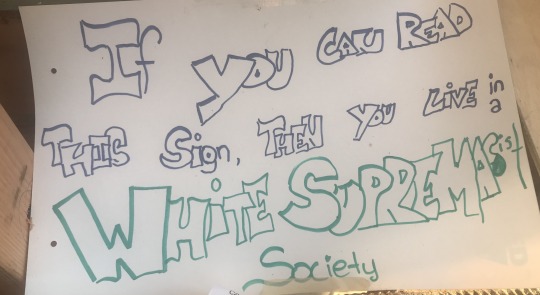
“Washing one’s hands off the conflict between the powerful and the powerless means to side with the powerful, not to be neutral.” — Paulo Freire
“The most common way people give up their power is by thinking they don’t have any.” — Alice Walker
To help to turn ideas of equality, justice and safety for all into practice, I’ve listed 70 strategies that white people can adopt in their lives to take a stance. Anti-racism is a verb. "I'm not a racist" disclaimer has never saved lives or contributed to greater equality in the workplace. We need direct action, online & offline. We need continuous efforts.
Fight for racial justice is an international and intersectional struggle. The strategies can be adapted or linked to others, which are more appropriate for different contexts.
**Note that this article is continually updated on agatapacho.wordpress.com
Action against police brutality & violence against immigrants
1. Follow and support The United Families & Friends Campaign (UFFC), a coalition of those affected by deaths in police, prison and psychiatric custody, supports others in similar situations. Participate in marches and demonstrations they organise, donate, spread the word.
2. Go to protests and demonstrations. When faced with the police, go to the front - you are less likely to be arrested and more likely to be treated with dignity.
3. When media outlets arrive to interview protesters, let POC speak. Don’t try to be the voice of the movement, be the ally.
4. Use your phone to record police arrests, racist attacks and racist behaviour. It will be easier to make a complaint afterwards. Make sure that the victim is ok with you sharing the recording with others.
5. Follow and support the work of organisations that monitor police, defend the right to protest and campaign for justice for those affected by police violence. You can find a list of organisations here.
6. Join Movement for Justice By Any Means Necessary, set up in 1995, following the murder of Stephen Lawrence, to tackle racism in institutional and established forms. Join demonstrations, which they organise against detention centres and deportations.
7. Support No Borders UK, a network of groups and individuals who fight against borders and immigration controls.
8. Download the Y-Stop app on your phone. The app is a tool for you to monitor how police stop and search is conducted. It helps you film and collect your own evidence and share it with Y-Stop, no longer having to rely on police records. It makes it easier for making a complaint about what happened and, for the victim, to access support and advice. Y-Stop is a project run by Release in partnership with StopWatch.
9. Attend trails to show support to POC. Remember that discrimination and white supremacy are institutionalised in the legal system and legal institutions.
10. Learn about the Windrush scandal and donate to The Windrush Justice Fund.
Out & about and AWARE
11. Don’t be shy to talk about white supremacy online and offline. Start with your friends, family and colleagues. Tell them that you care about racial justice and explain why it’s important to you. Invite them to the discussion, share articles and tweets that challenge problematic views.
12. Never be silent about that racist joke or remark. Calling people out gets more comfortable with time.
13. Challenge all forms of racism, from the use of N-word to those seemingly more innocent ones, for example, claims to colour-blindness.
14. Prepare yourself to tackle the usual racist arguments, such as ‘black on black crime’. See how others are doing it, learn about the origins of the racist remarks to be able to unpack them skilfully until the person understands the wrongness of them.
15. Support Black women. Promote their work and support their businesses. Challenge colourism (discrimination faced by darker-skinned black people) and jokes or negative comments about natural hair.
16. Attend active bystander training. Learn how to intervene when you witness a racist attack. Putting yourself at risk is not going to be useful. It’s safer to call out behaviour if you’re in a group. If this is not an option, report it to others who can act. Focus on the victim, ask if they need your help and what kind of help. When intervening, remember the four Ds: direct, distract, delegate, delay. Do not aggravate the situation - stick exactly to what has just happened. Distract by interrupting and starting a conversation with the perpetrator - this will help the victim to escape the situation. Delegate: find someone who can help and make sure that the help is offered to the victim. Delay: if it is too dangerous to challenge the attacker, help the victim to get them away to safety. You can report the situation later - this will be easier if you or someone else record the situation.
17. If you notice that you are being served first at a bar even though a POC was there before you, challenge the bar staff. Make a complaint and say that you won’t be visiting them again.
18. Blackface is never ok. It can always be avoided. That includes using Snapchat and Instagram filters to make your skin darker and using non-white emojis.
Online activism
19. Do not dismiss symbolic action. Use hashtags (#blm #blacklivesmatter #blackhistory #blackhistorymonth #nojusticenopeace), add frames to your FB profile picture. Gary Younge, professor of sociology at Manchester University, writes: “No one can claim a causal connection between #MeToo and the historic number of women that were elected to the US Congress a year later. But the contextual relationship between the two is hard to dismiss.”
20. Every time you witness, hear or read on social media about an instance of racism, complain. Contact the organisation, company, or an institution involved to express your disappointment. Share the story with others together with the contact details to encourage wider protests. The company might have initiated the event or failed to protect a POC from harm done by a third party. They need to hear from us. If you are dealing with a company that relies on customers, say that you will not spend money there. And stick to it!
21. Be vocal on social media about the misrepresentations and racist agenda in media. Do not accept them as a status quo.
22. Also, be critical of tokenism (Tokenism is the practice of making only a perfunctory or symbolic effort to be inclusive to members of minority groups, especially by recruiting a small number of people from underrepresented groups in order to give the appearance of racial or sexual equality within a workforce).
Decolonize your mind & your ways
23. Be a part of the decolonisation movement. If you are a student, demand that your curriculum includes a diverse list of writers of colour and their voices are considered not exclusively on topics of race and racism. If you are an educator, make sure that you introduce works written by POC. Encourage your colleagues to do the same. Encourage your students to let the school/university know diverse curriculum is important to them.
24. Find out how history is being taught at your child’s school and advocate that it is taught correctly when it comes to the topics of the British Empire, slavery and immigration. Naznin Rahman, Teacher of Sociology and Religious Studies, says that even younger non-white pupils may be aware that the statistics tend to portray them as under-achievers and, as a result, feel disempowered. At the same time, the way in which the curriculum is delivered has an impact on how they see themselves. Decolonised curriculum may be a tool of empowerment.
25. Scrutinise popular heroes and role models. Remain critical towards those cherished by the establishment. This article on Gandhi should do as a warning.
26. If you attend a cultural event that lacks diversity, challenge the organisers on that during a Q&A, or by contacting them afterwards. Share your disappointment on social media. Bad publicity may inspire change.
27. Visit institutions and attend events that promote artists of colour. Subscribe, purchase a membership and spread the word. If you are based London, check these out: Iniva, Black Cultural Archives, Autograph, Rich Mix, Royal African Society, 198 Contemporary Arts and Learning.
28. Join a group/society that engages with art produced by POC. If you can’t find one near you, start one.
29. Buy books and choose films and tv shows written and directed by non-white artists. Consider that when buying gifts for family and friends.
30. Decolonise your bookshelf. Make sure that, if you enjoy literature, you read authors of colour.
31. Avoid cultural appropriation. gal-dem explains: “At a basic level, cultural appropriation is the process of adopting certain elements of another culture, such as practices, ideas, or symbols, and removing them from their original cultural context. It is considered inappropriate for many reasons, such as the profiting off the intellectual property of other cultures, disrespecting spiritual or religious figures and practices, and the double-standards involved when a dominant culture adopts aspect of a culture they have historically oppressed.”
32. Do not buy from brands that appropriate non-western traditional attires profit with no recognition of the heritage behind them. This article explains the harm of cultural appropriation.
33. Always be critical of the media you consume and the information you encounter. Investigate who funds particular platforms, who are the intended audiences and who profits from certain representations of racial groups and events. It has been documented that stereotypes, myths and racist ideologies promoted in media have led to violence against POC. Claudia Rankine writes: “because white men can’t police their imagination, black men are dying”.
34. Watch films and tv series that have POC playing lead characters and that show full humanity of those characters.
35. There has been a reported renewal of interest in eugenics with London Conference on Intelligence meetings on eugenics secretly held at University College London. If you happen to hear about similar events, report them to the authorities and the University and College Union.
36. Be mindful of the pornography you consume and avoid racist content. The porn industry is affected by racism like any other industry.
Learn
37. Know British history. Learn about non-European history. Check out the work of David Olusoga who is one of the UK's foremost historians and an expert on the history of the British Empire.
38. Campaign to increase the visibility of soldiers of colour who fought for Britain. Share their histories on social media on Remembrance Day.
39. Explore BFI’s collection Black Britain on Film and the National Theatre’s Black Plays Archive.
40. Follow accounts that provide commentary on current events and issues: Gary Younge, Emma Dabiri, Akala, Reni Eddo-Lodge, Nikesh Shukla, Handsworth Revolution, Cyndi Handson Ellesse.
41. Follow Black Lives Matter UK, gal-dem, Media Diversified, S.M.I.L.E-ing Boys Project, Blacxellence.
42. Read ‘The Good Immigrant’ and follow authors who contributed to the collection.
43. If you are an educator, read bell hooks’ ��Teaching to Transgress’ and ‘Teaching Community’ to learn about diverse strategies and work towards anti-racist education.
44. Educate yourself about the history of activism of POC in the UK.
45. Educate yourself about the long history of contributions made by academics of colour to how we understand the world today.
At work
46. Campaign to hire more POC at your workplace, especially in managerial positions.
47. Whenever you can, speak against the Prevent Strategy.
48. Challenge your workplace if they exclusively make allowances for Christian festivals. Check if there is an accessible multi-faith prayer room. If there isn’t one already, campaign for setting it up.
Economic impact
49. Support business owned by POC. This website offers a list of independent Black British businesses. Choosing where you spend money is one of your most powerful weapons. Take away £££ from racist businesses and support POC.
50. Don’t support businesses that use prison labour. This article explains why prison labour is problematic.
51. Be aware of where your favourite brands choose to advertise - do they fund white supremacist media?
52. Always credit artists whose work you use to make your social media accounts interesting and pretty. Also, never claim credit for work you have not done. If you steal from a POC, the offence is even bigger.
53. Support artists of colour by investing in and purchasing their work. Don’t stream illegally.
54. Understand how the area where you live is affected by gentrification. Think about the impact of those changes on POC living there. Join local efforts against gentrification and support business that are at risk.
55. Buy makeup from brands that cater to everyone. Boycott those that don’t offer enough shades and inform them on social media about your decision.
Hold your MPs accountable
56. Vote for those who are committed to racial justice. Put pressure on your local MPs to specify how they are planning on tackling racism. Continue writing to them.
57. Keep yourself updated on changes to legislation. Write to your local MPs if you are concerned that new amendments can affect the lives of POC negatively. Start a petition and share your worry on social media. Let them know they are being watched.
58. Support the legalisation of the recreational use of cannabis. This is not because POC use it more frequently but because they are arrested for possessions more often.
Know how to be a part of the debate
59. Know that POC do not have the responsibility to share their experiences with you, educate you about racial inequality or even discuss it. That also refers to the conversations you have with those who are your friends or partners.
60. At the same time, appreciate when they do share their knowledge and experiences and advise you on how you can help.
61. When attending events organised by POC, focus on listening and learning. Don’t question speakers’ experiences of racial discrimination, do not compare their experiences to yours, do not assume that you know already. Appreciate that you’re allowed into that space and remain respectful.
62. When told about someone’s experiences of racism, never ask for evidence or challenge them. Don’t suggest waiting out - you are asking them to continue to suffer.
63. Do not rush to share videos of police brutality with your friends/colleagues/partners who are POC. Accept that they are affected to a far greater extent than you are. Also, do not tell them how to grieve or how to cope with the trauma. Be there to listen and care.
64. It’s ok if you’re not welcomed to all spaces. Respect the right of POC to exclude you from the conversation. Reni Eddo-Lodge cites her friend who advocates the need for creating spaces exclusively for black women. That’s how she describes participating in mixed feminist groups: “Even if you’re really confident and really vocal, there is still a holding back that you have to do. Because as a normal human being, you kind of don’t really like confrontation. And there’s an element of just speaking the truth of what it means to be a black woman in the UK that it would be ridiculous, as a white person, to not read that as implication you.”
65. When a POC complaints about racism to you, don’t take it personally. Unless they are specifically referring to your actions, it is not about you. They talk about the systematic racism, which you have the responsibility to fight. Listen to the complaints and learn from them how you can do better.
66. Don’t whitesplain. Ever. No, you do not know better. Ever.
67. Don’t play devil’s advocate in debates about racism. You’re only restating and reinforcing the status quo, disrespecting others’ critical thinking skills and positioning your thought process as superior and more valuable than someone’s lived experience. As a consequence, you are more likely to shut down the conversation rather than add to it or learn from it.
68. Make sure that you know the difference between well-meaning and consequences. Having good intentions isn’t enough. Always consider the potential consequences of your actions on the lives and well-being of POC.
Final thoughts
69. Do not feel demotivated if your efforts are not recognised. Keep doing the work when no one is watching. As Chimamanda Ngozi Adichie famously said, “'Racism should never have happened and so you don't get a cookie for reducing it.”
70. Support other allies who put themselves in dangerous situations to fight for racial justice. The Stansted 15, a group of non-violent human rights activists who took action to stop a deportation flight leaving from Stansted Airport were spared jail after campaigns in their defence.
This post has been inspired by Corinne Shutack’s article.
1 note
·
View note
Text
Comparative analysis of Homer and Atwood’s Penelope
When discussing Homer’s, The Odyssey and Margaret Atwood’s novella The Penelopiad, a retelling of Homer’s myth, it is easy to fall into the trap of giving more thought to the considerable differences, of which there are undoubtedly many, than to what may be similar. There are thousands of years seperating Homer’s epic and Atwood’s retelling. The Odyssey is written in verse while The Penelopiad is mostly written in prose. Further, there is also much to examine when considering the feminist undertones of The Penelopiad compared to The Odyssey. This paper will explore the concepts of feminism within these texts by investigating differences and continuities between the texts. This paper will first examine the differences between the characterisation of Odysseus and the dichotomies of luck - which this paper will interpret as divine intervention - and skill, between the depictions of Odysseus’s journey back to Ithaca within The Odyssey and The Penelopiad. This paper will then explore the characterisation of Penelope and argue that the Penelope of The Odyssey can be read as a feminist figure and is as wily and cunning as her characterisation in Atwood’s The Penelopiad. However, this paper will ultimately argue that Homer’s Penelope is constructed to be “a stick used to beat other women with” (Atwood 2). Finally, this paper will examine the largest difference between the texts, Atwood’s increased focus upon the hanged maids, exploring how Atwood uses the maids as a metaphor for female power, while providing the closest stylistic connection to the tradition of Homer’s myth. Much discussion has taken place around Atwood’s shift of the narrative focus away from the male perspective of Odysseus and onto the female voices and perspectives within the narrative, namely Penelope. While it is irrefutable that The Odyssey is a male-centric and dominated narrative, there are female figures who play a pivotal role within the story. Namely, one of the most recognised figures of female power in western cannon, the goddess Athena. Having the literal goddess of wisdom and crafts, arguably the strongest representation of feminine power, function as a guiding hand ensuring the safety of Odysseus for merely admiring his wits (Sommor et al. 2) can certainly be read as a feminist portrayal. However, there are elements within The Odyssey that diminish Athena’s feminine power. Most tellingly Athena only presents herself to the male characters of Odysseus and Telemachus, making a strong female presence a bystander in a man’s narrative. Another example of Athena’s femininity being reduced is when she is needed as an integral agent in the plot to return Odysseus to his home in Ithaca. In order to be taken seriously by Odysseus’s son Telemachus she must appear to him as a man (Sommor et al. 5). It could also be argued that when acting as mentor to Telemachus, Athena imparts lessons and virtues that are traditionally viewed as ‘feminine’ such as, hope, sense and adeptness (Sommor et al. 5). In one instance, it can be read that Athena acts as the societal archetype of the female nag when she dissuades Telemachus’ from nonsensical activities, reminding him to be mindful of what truly matters (Sommor et al. 8). In Atwood’s The Penelopiad, no such power is given to divinity, rather divinity is given little mention at all within the narrative. By shifting the narrative focus away from Odysseus and onto Penelope, Atwood removes many of fantastical elements of Odysseus’s journey and elevates the mundane. By sapping the recognisable supernatural mythic elements – cyclopes and sirens amongst other examples – Atwood is also able to reduce Odysseus’s mythic status, diminishing Odysseus’s exploits with monsters and gods to mere rumor and gossip (Howells 9) “Odysseus had been in a fight with a giant one-eyed Cyclops, said some; no it was a one-eyed tavern keeper, said another” (Atwood 83). As Atwood shifted the perspective of the narrative to Penelope she has also played a role in shifting how the character Penelope is perceived. In her novella, Atwood characterises Penelope as shrewd, cunning and caustically self-aware of her own canonised image as the perfect, virtuous woman. This characterisation is in part created through Penelope’s reaction to Odysseus’s return and her relationship to Helen. A widely-cited difference between Atwood’s and Homer’s Penelope is the notion of when Penelope is aware of Odysseus’s return. The Penelopiad makes it clear that Penelope is not fooled by Odysseus’s ruse “His disguise was well enough done…but as soon as I saw the barrel chest and those short legs I had a deep suspicion, which became a certainty when I heard he’d broken the neck of a belligerent fellow panhandler.” (Atwood 136). This early recognition is often held up as an example of Atwood’s Penelope being a more cunning figure then the Penelope of The Odyssey, however, it should be acknowledged that Homer’s Penelope is also cited for her cleverness due to her shroud deception. There are some academics however, who argue that due to early scholar’s misinterpretation of the word ‘stranger’ in the scene where Penelope encounters a disguised Odysseus (Vlahous 2) led to a wide-spread belief that Penelope does not recognise her husband; when there is evidence of Penelope’s early recognition. A common understanding of Penelope’s early recognition comes in book 19 as the disguised Odysseus is able to answer Penelope’s questions about the clothes and jewelry Odysseus was wearing when he first departed Ithaca in great detail (Vlahous 6). It is argued that from this exchange Penelope is able to devise a test that only Odysseus could complete, leading to the ‘bed test’ of book 23 that cements Penelope’s certainty that Odysseus has returned (Vlahous 6). This shows that that Homer’s Penelope displays a cleverness and shrewdness that goes beyond her shroud trick. Another argument made for a more sophisticated reading of Homer’s Penelope is her relationship to her cousin Helen. Though a relatively minor character in The Odyssey, Helen looms large in The Penelopiad. Throughout the novella, Penelope is unabashedly unkind towards Helen, titling a chapter “Helen Ruins My Life” (Atwood 71) and expressing dismay that Helen never faced any punishment over her transgressions when others face death by drowning, sea serpent and arrow for what Penelope considers to be lesser crimes (Atwood 22). Academic Gabrielle Neethling asserts that Atwood has constructed this antagonistic relationship between the cousins for Helen to serve as a shadow figure to Penelope, a mirror reflecting the things that Penelope knows, yet dislikes about herself and the injustice of being held up as a paradigm of the perfect woman when she knows she is guilty of transgressing in similar ways to Helen (Neethling 119-122). As mentioned throughout this paper Homer’s Penelope has been used as a high watermark for the archetype of an idealised faithful wife, however, there are readings of the character that are in keeping with Atwood’s portrait of a far more complicated woman. Academic Keri Ames posits that Homer’s Penelope is also concerned with the concept of transgression, as evidenced through her avid support of Helen, her adultery and abandonment of home (136). Ames goes on to contend that this defense of Helen is a reaction to Penelope being fearful that she to is likely to commit the same transgression and that it is only through the mercy of the gods that she has been able to remain faithful to her own marriage (136). In The Penelopiad, Atwood makes it clear that Penelope has a deeply complicated relationship to her own image as an ideal, faithful wife who is perceived to be rewarded for duplicitous acts because they enacted for the good of her family, “Why couldn’t they be as considerate, as trustworthy, as all-suffering as I had been?” (Atwood 2). This self-awareness and serious consideration of her perception is where these two versions of Penelope diverge. Academic Sarah Bolmarcich provides an interesting reading, suggesting that perhaps by elevating her status Homer has knowingly created a strong female character, similar to Atwood’s. Bolmarcich suggests that Odysseus’s speech Nausicaa “there is nothing better or finer then when two people of one heart and mind keep house as man and wife, a grief to their enemies and a joy to their friends” (Homer 80) situates Penelope into a position of power afforded to no other woman in The Odyssey (Bolmarcich 205). Bolmarcich highlights Homer’s use of a Greek word within the passage above describing Odysseus’s marriage to Penelope that translates to a relationship between male comrades (211). This passage acts as a treatise into what Homer considers to be an ideal marriage and more importantly how a woman should act within her marriage (Bolmarcich 206-207). It could be argued that Penelope’s elevation to a position that is the same as a man’s, in tandem with the high regard that such relationships were held during the time of Homer’s writing shows that Penelope is intended to be held up as a strong woman (Bolmarcich 211). However, it is the view of this paper that for Penelope to be seen as a good and trustworthy partner she must have her femininity diminished and act in more masculine ways; whereas women, such as Helen who act in traditionally feminine ways are relegated to the archetype of bad wife (Bolmarcich 213) proves that Homer’s Penelope is constructed to be the “stick to beat other woman with” (Atwood 2) that Atwood’s Penelope understands her image to be. As discussed above two of greatest differences between The Odyssey and The Penelopiad is Atwood’s increased focus on the murdered maids and the vast differences in form. The Penelopiad is largely written in modern prose, from the perspective of Penelope, from the underworld, where she uses anachronistic language. All of these elements serve to distance Atwood’s Penelope from the male dominated narrative of The Odyssey. However, sprinkled throughout The Penelopiad are short asides, including sea shanties, laments and a anthropology lecture are given by the maids; who are given no voice in The Odyssey. Interestingly Atwood’s use of the maids provides the closest stylistic relationship to Homer’s narrative. Academic Hilde Staels argues that Atwood’s use of the maids ‘chorus line’ asides serve as the Greek chorus, commenting upon the story from an outside perspective (Staels 104). Staels goes on to argue that Atwood’s use of the maids provides her narrative with the mythic elements that she strips from Odysseus’s story. By having Odysseus murder the maids, maids that Staels believes act as twelve manifestations of the moon goddess Artemis, a goddess associated with womanhood, that Atwood is enacting a vegetation myth (104). As the maids, figures of female power die, the rebirth of Penelope can occur, allowing for the narrative to be taken from the men of The Odyssey and become the story of and the reclamation of the power of the women of The Penelopiad (Staels 104). There are many clear differences between The Odyssey and The Penelopiad, however, there are also many continuities between the texts. By engaging with close readings of these texts the reader is able to find a more feminist understanding of the male-centric Odyssey and a more traditional mythic understanding of the radically modern Penelopiad; such readings are only a matter of interpretation.
#greek mythology#homer#homer's odyssey#the odyssey#penelope#margret atwood#the penelopiad#academic writing#academic essay#college student#college writing#college#college essay#college studyblr#uni#uni student#uni studyblr#university#university student#university writing#university essay#university studyblr
2 notes
·
View notes
Text
Incantations: Powerful Magic, At A Cost...
Incantations are like spells, but they can be cast by characters who are not spellcasters.
This variant enables characters who know the correct ritual gestures and phrases for an incantation to achieve powerful magic effects.
Incantations don’t use spell slots, you don’t have to prepare them ahead of time, and you can use an incantation an unlimited number of times per day.
Incantations have drawbacks: They’re time-consuming to cast, and success isn’t assured.
They are often expensive, and some require additional participants to complete the ritual.
Some incantations work only under certain specifi c conditions, such as during a full moon.
Most important among the drawbacks, an incantation rarely fades away quietly if the caster fails to perform the ritual correctly.
Instead it reverses itself on the caster, explodes with a cascade of magical energy, or weakens the barrier between worlds, enabling hostile outsiders to emerge onto the Material Plane.
This variant gives a measure of magical power to non-spellcasters, but the incantations themselves are usually too specific in effect to increase a character’s power in the general sense.
Because many incantations require academic skills such as Knowledge, the characters best equipped to cast them are often spellcasters anyway.
Incantations provide a useful way to introduce powerful magical effects in a lower-level game under controlled conditions.
PCs will still use spells rather than expensive, risky incantations whenever they can.
Incantations are also more specific than spells, so the DM can introduce them into the game without worrying that they’ll spread beyond the immediate situation.
If you want characters in your low-level game to take a brief sojourn to Ysgard, you can introduce the incantation Hrothgar’s journey.
Because it requires the construction of a thatched hut in the middle of a forest and works only during the winter solstice, you don’t have to worry about the characters exploring the Outer Planes whenever they get the urge.
If you gave low-level PCs easy access to the plane shift spell, on the other hand, they could wander the planes until they ran afoul of the first outsider more powerful than they are (which is almost any outsider).
DISCOVERING INCANTATIONS
Obscure tomes and spellbooks filled with mystical ramblings, descriptions of magic theory, ordinary arcane spells, and utterly useless or incomprehensible magical writing often hide the instructions for performing incantations.
In those dusty volumes, diligent readers can find incantations with real power—magical recipes that provide step-by-step instructions for achieving a powerful effect.
If the characters have access to a well-stocked library of magical information, finding a set of instructions for a particular incantation requires a successful Knowledge (arcana) check with a DC 10, lower than the DC for casting the incantation.
Just being aware of the existence of a particular incantation requires a Knowledge (arcana) check with a DC 15, lower than the incantation’s casting DC.
CASTING AN INCANTATION
At its simplest, casting an incantation is akin to preparing and cooking something according to a recipe.
You must have the ingredients in hand, then use your skill in cooking to perform each step in order.
In game terms, this means having the required incantation components, then succeeding on a number of skill checks—often Knowledge (arcana) checks—during the incantation’s casting time.
Each incantation description tells how many successful skill checks are required to cast the incantation.
Unless otherwise specified, the caster makes a skill check every 30 minutes.
If checks involving more than one skill are required, the checks may be made in any order, as desired by the caster.
Failing one skill check means that 30 minutes have gone by, and the incantation is in danger of failing.
If two skill checks in a row are failed, the incantation fails.
Each incantation has a consequence associated with failure.
Even if the incantation fails, the casting still consumes all the components (including expensive material components and experience points).
Because of the unusual outcomes possible on a failure, the DM may choose to make these skill checks in secret.
Doing this prevents the player of the caster from knowing whether an incantation has succeeded or failed.
If the consequence of failure is immediate and severe (such as death resulting from a failed Fires of Dis incantation), the effect is obvious, and concealing it serves no purpose.
Many incantations have a backlash component, which is an ill effect suffered by the caster at the conclusion of the casting or upon failure of the incantation (see Backlash, below).
SAVES AND SPELL RESISTANCE
If an incantation allows a save, the formula to calculate the save is included in the incantation’s description.
For checks to overcome spell resistance, divide the incantation’s skill check DC by 2 to get the effective caster level for the spell resistance check.
For example, the caster of a Fires of Dis incantation (DC 20) would add +10 to a d20 roll when attempting to overcome the spell resistance of the target.
INTERRUPTING INCANTATIONS
Incantations take a long time to cast, but they aren’t as delicate and exacting as traditional spells.
Casting an incantation does not provoke an attack of opportunity, and a caster can even pause the ritual for a short time in order to fight, cast a spell, or take some other action.
For each round the incantation is interrupted, the DC of all subsequent skill checks to complete the casting increases by 1.
Time spent during the interruption of an incantation does not count toward the incantation’s casting time.
INCANTATION COMPONENTS
Most incantations require components not unlike those of spells, including verbal, somatic, focus, and material components.
In addition, some require secondary casters (abbreviated SC in the Components line of a description), or cause some sort of backlash (abbreviated B), or cost the caster some amount of experience points (abbreviated XP).
SECONDARY CASTERS
Some incantations require multiple participants to have any hope of succeeding.
These secondary casters are indispensable to the success of the incantation.
However, no matter how many people are gathered in the dark room, chanting with candles, only one character—most commonly the one with the highest modifier in the relevant skill—is the primary caster who makes the relevant checks.
Secondary casters can’t help the primary caster succeed by means of the aid another action, but their presence is required for certain aspects of the ritual nonetheless.
Often, an incantation is hosted with more than the minimum number of casters.
If the primary caster or a secondary caster is killed or disabled, one of these bystanders can step into a role.
If an incantation requires a check involving a skill other than Knowledge (arcana), any secondary caster can make that check if he or she has a higher skill modifier than the primary caster.
Casters who favor the Hrothgar’s journey incantation, for example, keep bards on hand if they aren’t highly skilled in the Performance Skill themselves.
BACKLASH
Some incantations damage or drain the caster in some way when they are cast.
They have a backlash component: damage, negative levels, or some other effect.
The caster experiences the backlash effect regardless of the success or failure of the incantation.
FAILED INCANTATIONS
When two skill checks in a row result in failure (whether or not they’re made by the same character), the incantation as a whole fails.
The character who failed the second check experiences the effect indicated in the incantation’s description.
In general, the consequences of failure can be divided into the following categories.
(Many of these effects are not mentioned in the sample incantations that follow; they are provided here for use in incantations that could be developed for a campaign.)
Attack: A creature is called from elsewhere to battle the caster (and often any bystanders and secondary casters).
The incantation’s description tells the DM what Challenge Rating the creature should have, how it behaves, and how long it persists.
Augment: The incantation was supposed to weaken or destroy its target, but it makes the target more powerful instead.
An incantation that deals damage might heal its target or cause it to grow in power, for example.
Betrayal: The incantation seemingly succeeds, but the subject of the incantation (or, in rare cases, the caster) undergoes a dramatic alignment change.
Over the next 1d6 minutes, the subject’s alignment becomes the extreme opposite of what it was previously (for instance, lawful good becomes chaotic evil, or chaotic neutral becomes lawful neutral; a neutral subject randomly becomes lawful good, lawful evil, chaotic good, or chaotic evil).
The subject generally tries to keep its new outlook a secret.
Damage: Either the caster or the target takes damage as the consequence of failure.
Death: Someone—usually the caster or the target—dies.
Some incantations allow a saving throw to avoid this consequence of failure.
Delusion: The caster believes the incantation had the desired effect, but in fact it had no effect or a very different one.
Falsehood: The incantation (typically a divination) delivers false results to the caster, but the caster believes the results are true.
Hostile Spell: The caster of the incantation is targeted by a harmful spell.
The incantation description gives the specific spell, save DC, and other particulars.
Mirrorcast: The incantation has the opposite effect of what was intended.
Reversal: The incantation affects the caster rather than the intended target.
SAMPLE INCANTATIONS
The following incantations are among the better-known incantations in existence—which means that no more than a few eldritch scholars know about them.
Characters can learn of their existence during the course of an adventure by making a Knowledge (arcana) check (see Discovering Incantations, above).
Call Forth the Dweller
Divination
Effective Level: 6th
Skill Check: Knowledge (arcana) DC 16, 2 successes
Failure: Falsehood
Components: V, S, M, F, XP, B
Casting Time: 60 minutes
Range: Personal
Target: You
Duration: Instantaneous
Saving Throw: None
This incantation contacts the enigmatic, extra-dimensional being known as the Dweller on the Threshold, an entity that imparts knowledge about its specific obsession: doors and other entrances.
To cast call forth the Dweller, the caster must inscribe forty-two mystic symbols around an open doorway, then begin the chants and supplications required for the incantation.
If the incantation succeeds, an image of the Dweller—an inky mass of tentacles and mouths—appears on the other side of the doorway.
The Dweller on the Threshold truthfully answers any questions it is asked about a particular door.
For example, the Dweller can provide a magical password that unlocks a door, indicate how to disarm a trap on a door, reveal the weaknesses of a door’s guardian, or describe the room that lies beyond the door.
Its answers are clear and fairly specific, if somewhat terse.
The caster may well appreciate such concise answers, because one of the forty-two symbols inscribed around the doorway during the casting of the incantation fades away with each word the Dweller on the Threshold speaks—and when all the symbols are gone, the Dweller disappears.
If the caster asks the Dweller on the Threshold a question that doesn’t involve doors, the Dweller responds with a cutting insult, often about something the caster thought was secret.
Each word of the insult likewise makes a symbol disappear from the perimeter of the doorway.
The exact nature of the Dweller on the Threshold is shrouded in mystery.
Some contend that it is somehow connected to Vecna, god of secrets, although no one has ever found conclusive evidence that the Dweller on the Threshold is evil.
Option: If the doorway used as the focus is one that the Dweller has been asked about in the past, the caster gains a +4 bonus on the Knowledge (arcana) checks during the incantation.
For example, if Mialee uses call forth the Dweller to learn about the Gateway to Despair, then when she reaches the Gateway, she can use the Gateway as the focus and gain a +4 bonus when she uses the incantation to ask about the Arches of Certain Doom.
Failure: If the caster fails two consecutive Knowledge (arcana) checks, the Dweller on the Threshold gleefully lies, employing falsehoods that demonstrate its inclination toward mischief and cruelty.
Material Component: Forty-two mystic symbols inscribed around the perimeter of the focus doorway (requiring materials costing 500 gp).
As described above, these symbols gradually disappear during the time the incantation is in effect.
Focus: An open doorway large enough to allow a Medium creature to pass through it.
XP Component: 400 XP.
Backlash: After speaking with the Dweller on the Threshold, the caster is exhausted.
Campaign Use: This incantation is an obvious solution for characters who are “stuck” by an especially impenetrable door.
The exhaustion backlash makes it less likely they immediately try the door after casting the incantation, and the XP cost ensures that they won’t try to use call forth the Dweller on every door they face.
If you introduce this incantation in your game, you’re giving the PCs occasional access to a powerful divination.
But because it’s rather specific, it doesn’t make the characters more powerful.
Typically, getting through a door lands PCs in trouble more quickly than if they were unable to pass the portal.
Fires of Dis
Conjuration (Calling)
Effective Level: 6th
Skill Check: Knowledge (arcana) DC 20, 3 successes; Knowledge (religion) DC 20, 2 successes; Knowledge (the planes) DC 20, 1 success
Failure: Death
Components: V, S, M, XP, SC, B
Casting Time: 90 minutes
Range: Touch
Effect: 80ft. radius burst centered on caster
Duration: Instantaneous
This incantation, dreamed up by insane cultists, opens a fell rift between the Material Plane and Dis, the fiery second layer of the Nine Hells.
This rift brings about a massive conflagration that destroys almost everything in the immediate area, then releases a powerful devil who capers over the smoldering ruins and begins to rampage across the countryside.
The Fires of Dis ignite everything they touch—except for the caster, who is transported to Dis as the result of the incantation’s backlash.
When the incantation is complete, the Fires of Dis fill an 80-foot-radius spread around the caster’s former location, dealing 18d6 points of fire damage to all creatures and objects.
Additionally, everything flammable in that radius is now on fire (as described in "Catching on Fire").
In the following round, a pit fiend comes through the rift, which then closes.
The creature begins to destroy everything in sight.
Failure: Death of the character who failed the second consecutive skill check.
Material Component: Rare unguents and dark alchemical concoctions worth 5,000 gp.
XP Component: 1,000 XP.
Backlash: The caster is knocked unconscious and transported to Dis (no save).
Extra Casters: Six required; they chant choruses and supplications to various dark deities throughout the incantation.
Campaign Use: Obviously, the backlash component is significant enough that most PCs will not seriously consider casting this incantation.
But even a low-to mid-level character has a decent chance of making all the skill checks without failing twice in a row, so the incantation could show up in a campaign in a number of different circumstances.
For instance, the PCs may be tipped off that suicidal cultists are trying to bring the Fires of Dis to their city, and they have to disrupt the incantation.
The Fires of Dis might also have a place in a mystery adventure, where the PCs must discover who stole rare alchemical compounds.
A routine investigation takes on new urgency when the PCs find out that the missing vials can be the material component for a Fires of Dis incantation.
Hrothgar’s Journey
Conjuration (Teleportation)
Effective Level: 6th
Skill Check: Knowledge (arcana) DC 20, 2 successes; Performance DC 20, 2 successes
Failure: 5d6 points of fire damage to caster
Components: V, S, M, SC, B
Casting Time: 60 minutes
Range: Touch
Target or Targets: Caster plus four to twelve other creatures
Duration: Instantaneous
Hrothgar’s journey is an incantation based on the tale of Hrothgar, a powerful barbarian hero from ages past.
When the poetic epic of Hrothgar is recited in the stifling heat of a sweat lodge during the winter solstice, the orator and his listeners receive the same final reward that Hrothgar did: a one-way trip to Ysgard’s plain of Ida, where they can drink and make merry with the greatest warriors of myth.
To cast the incantation, the caster must construct a small, windowless hut in the middle of the forest, then build a bonfire in the hut’s center.
At least four and up to twelve others accompany the caster into the hut.
Then the flames are lit and the telling of the tale of Hrothgar begins.
Because the bonfire is large and the hut is small, the atmosphere inside quickly gets stiflingly hot.
This is the incantation’s backlash; unlike most backlash components, it affects the incantation’s other targets as well as the caster.
Any creature inside the hut must make a Constitution Saving Throw every 30 minutes or suffer the effects of Exhaustion.
Just as the tale of Hrothgar approaches its conclusion (near the end of the casting time), the bonfire’s flames light the hut on fire, which creates a great deal of smoke but no additional heat or damage.
If the final skill check succeeds, the flames consume the hut’s roof and walls, revealing the plain of Ida on the plane of Ysgard.
Material Component: A windowless, thatched hut in a forest.
Backlash Component: Severe heat, Exhaustion
Extra Casters: Four required; they provide the dialogue for other characters in the epic of Hrothgar.
Campaign Use: Hrothgar’s journey is well within the reach of mid-level PCs, especially bards.
Of all the Outer Planes, Ysgard is perhaps the most hospitable to PCs and the easiest to work into an ongoing campaign, so the incantation may be a good way to wet the players’ appetite for planar travel without opening up the entire cosmology.
In the hands of NPCs, Hrothgar’s journey can be an escape route for the barbarian raiders the characters have been chasing for months.
Or a mischievous NPC bard can beckon the PCs into a warm hut on a cold winter’s night, promising them a wondrous reward if they just listen to a tale. . . .
#magic spells#homebrew rules#homebrew#homebrew spells#magic#dungeons and dragons#dungeons & dragons#dnd 5e#dnd 3.5#d&d 5e#community#comments#communityresponse#CreativeRogues
405 notes
·
View notes
Text
Sondland’s testimony shows Mike Pompeo was far more central on Ukraine than we knew

US Ambassador to the European Union Gordon Sondland arrives to testify before the House Intelligence Committee, on Nov. 20, 2019. | Andrew Harnik/AP
Sondland’s testimony was devastating for the secretary of state.
Secretary of State Mike Pompeo was more centrally involved in the Ukraine scheme than originally known — confirming the plan to pressure Ukraine to investigate Joe Biden, his son Hunter, and Democrats made its way to the very top of the Trump administration’s foreign policy team.
That stunning revelation came during Wednesday’s impeachment hearing in the opening testimony of Gordon Sondland, the US ambassador to the European Union. It was known that Pompeo was aware of the plan — for example, he was on the July 25 call between President Donald Trump and Ukrainian President Volodymyr Zelensky — but the extent of his knowledge of the quid pro quo is new and damning.
Sondland outlined three specific instances in which Pompeo was made aware of the Ukraine scheme, and one where he directed US diplomats to engage with Trump’s personal lawyer Rudy Giuliani. Which means Pompeo wasn’t just an innocent bystander, blissfully unaware of what was going on — he was actively involved.
All this time there has been talk of two policies toward Ukraine: a traditional one led by US officials and an irregular one led by Giuliani. But after Sondland’s testimony, it’s pretty clear Pompeo played a role in both.

Drew Angerer/Getty Images
US Secretary of State Mike Pompeo at the US Department of State on November 18, 2019.
Pompeo was aware of the Ukraine quid pro quo
“Was there a ‘quid pro quo?’” Sondland rhetorically asked the House Intelligence Committee. “The answer is yes,” adding later, “Everyone was in the loop.”
Pompeo is clearly included in “everyone” based on four specific instances the ambassador detailed in his opening testimony.
The first example is a July 19 email received by the secretary of state and other top officials, including acting White House Chief of Staff Mick Mulvaney.
“I Talked to Zelensky just now … He is prepared to receive Potus’ call. Will assure him that he intends to run a fully transparent investigation and will ‘turn over every stone,’” Sondland wrote. “He would greatly appreciate a call prior to Sunday so that he can put out some media about a ‘friendly and productive call’ (no details) prior to Ukraine election on Sunday.”

In other words, Sondland informed Ukraine’s president that he needed to commit to investigate the Bidens and Democrats during a future call with Trump. If Zelensky had complied, the quid pro quo plan would’ve nearly been complete — and Pompeo was aware.
Second, Sondland also revealed an email sent on August 11 to Ulrich Brechbuhl, a top adviser to Pompeo, and Lisa Kenna, the top diplomat’s executive secretary.
With the subject line “Ukraine,” Sondland wrote: “Mike – [former special Ukraine envoy] Kurt [Volker] and I negotiated a statement from Ze[lensky] to be delivered for our review in a day or two. The contents will hopefully make the boss happy enough to authorize an invitation. Ze plans to have a big presser on the openness subject (including specifics) next week.”
“Gordon, I’ll pass to S,” Kenna replied, using the State Department’s abbreviation for the secretary of state. “Thank you.”

That’s big. As secretary of state, Pompeo surely knew how important it was for Zelensky to have a meeting with Trump to show America has Ukraine’s back as it fights off Russia’s invasion. Yet Sondland’s email made it clear that such a meeting was conditioned on Kyiv agreeing to open investigations into the Bidens and Democrats. It’s unclear, though, how Pompeo responded.
Third, Sondland detailed an August 22 email that he sent directly to Pompeo and copied Kenna about planning for a Trump-Zelensky meeting in Warsaw.
“Should we block time in Warsaw for a short pull-aside for Potus to meet Zelensky? I would ask Zelensky to look him in the eye and tell him that once Ukraine’s new justice folks are in place ([in] mid-Sept[ember), that Ze[lensky] should be able to move forward publicly and with confidence on those issues of importance to Potus and to the US,” Sondland wrote. “Hopefully, that will break the logjam.”
Per Sondland, Pompeo simply replied, “Yes.”

Sondland was worried that nearly $400 million in military aid for Ukraine was purposefully held up, but he didn’t know why. His hope was that a brief Trump-Zelensky chat might lead the president to release the funds, and it seemed that Pompeo agreed. Trump, however, didn’t go to Warsaw and sent Vice President Mike Pence in his stead.
Finally, Sondland noted that “[e]ven as late as September 24, Secretary Pompeo was directing Kurt Volker to speak with Rudy Giuliani. In a WhatsApp message, Kurt Volker told me in part: ‘Spoke w Rudy per guidance from S.’” Remember that “S” is the State Department’s single-letter abbreviation for the secretary of state.

Which means that Pompeo knew how central Giuliani was to the scheme, and encouraged Sondland — and perhaps others — to coordinate with the president’s personal lawyer on Ukraine policy.
Put together, there’s just no way Pompeo can feign ignorance when it comes to the administration’s true aim toward Ukraine. He was not only made aware if it, but in at least one instance directed a specific action — the outreach to Giuliani.
This is all potentially damaging for his future political aspirations, and it may further embroil Pompeo in a crisis he’s tried hard to stay away from. At this point it wouldn’t be surprising — or unwarranted — for House Democrats to ask Pompeo to testify based on Sondland’s testimony.
from Vox - All https://ift.tt/2rdKpV2
0 notes
Text
Sondland’s testimony shows Mike Pompeo was far more central on Ukraine than we knew

US Ambassador to the European Union Gordon Sondland arrives to testify before the House Intelligence Committee, on Nov. 20, 2019. | Andrew Harnik/AP
Sondland’s testimony was devastating for the secretary of state.
Secretary of State Mike Pompeo was more centrally involved in the Ukraine scheme than originally known — confirming the plan to pressure Ukraine to investigate Joe Biden, his son Hunter, and Democrats made its way to the very top of the Trump administration’s foreign policy team.
That stunning revelation came during Wednesday’s impeachment hearing in the opening testimony of Gordon Sondland, the US ambassador to the European Union. It was known that Pompeo was aware of the plan — for example, he was on the July 25 call between President Donald Trump and Ukrainian President Volodymyr Zelensky — but the extent of his knowledge of the quid pro quo is new and damning.
Sondland outlined three specific instances in which Pompeo was made aware of the Ukraine scheme, and one where he directed US diplomats to engage with Trump’s personal lawyer Rudy Giuliani. Which means Pompeo wasn’t just an innocent bystander, blissfully unaware of what was going on — he was actively involved.
All this time there has been talk of two policies toward Ukraine: a traditional one led by US officials and an irregular one led by Giuliani. But after Sondland’s testimony, it’s pretty clear Pompeo played a role in both.

Drew Angerer/Getty Images
US Secretary of State Mike Pompeo at the US Department of State on November 18, 2019.
Pompeo was aware of the Ukraine quid pro quo
“Was there a ‘quid pro quo?’” Sondland rhetorically asked the House Intelligence Committee. “The answer is yes,” adding later, “Everyone was in the loop.”
Pompeo is clearly included in “everyone” based on four specific instances the ambassador detailed in his opening testimony.
The first example is a July 19 email received by the secretary of state and other top officials, including acting White House Chief of Staff Mick Mulvaney.
“I Talked to Zelensky just now … He is prepared to receive Potus’ call. Will assure him that he intends to run a fully transparent investigation and will ‘turn over every stone,’” Sondland wrote. “He would greatly appreciate a call prior to Sunday so that he can put out some media about a ‘friendly and productive call’ (no details) prior to Ukraine election on Sunday.”

In other words, Sondland informed Ukraine’s president that he needed to commit to investigate the Bidens and Democrats during a future call with Trump. If Zelensky had complied, the quid pro quo plan would’ve nearly been complete — and Pompeo was aware.
Second, Sondland also revealed an email sent on August 11 to Ulrich Brechbuhl, a top adviser to Pompeo, and Lisa Kenna, the top diplomat’s executive secretary.
With the subject line “Ukraine,” Sondland wrote: “Mike – [former special Ukraine envoy] Kurt [Volker] and I negotiated a statement from Ze[lensky] to be delivered for our review in a day or two. The contents will hopefully make the boss happy enough to authorize an invitation. Ze plans to have a big presser on the openness subject (including specifics) next week.”
“Gordon, I’ll pass to S,” Kenna replied, using the State Department’s abbreviation for the secretary of state. “Thank you.”

That’s big. As secretary of state, Pompeo surely knew how important it was for Zelensky to have a meeting with Trump to show America has Ukraine’s back as it fights off Russia’s invasion. Yet Sondland’s email made it clear that such a meeting was conditioned on Kyiv agreeing to open investigations into the Bidens and Democrats. It’s unclear, though, how Pompeo responded.
Third, Sondland detailed an August 22 email that he sent directly to Pompeo and copied Kenna about planning for a Trump-Zelensky meeting in Warsaw.
“Should we block time in Warsaw for a short pull-aside for Potus to meet Zelensky? I would ask Zelensky to look him in the eye and tell him that once Ukraine’s new justice folks are in place ([in] mid-Sept[ember), that Ze[lensky] should be able to move forward publicly and with confidence on those issues of importance to Potus and to the US,” Sondland wrote. “Hopefully, that will break the logjam.”
Per Sondland, Pompeo simply replied, “Yes.”

Sondland was worried that nearly $400 million in military aid for Ukraine was purposefully held up, but he didn’t know why. His hope was that a brief Trump-Zelensky chat might lead the president to release the funds, and it seemed that Pompeo agreed. Trump, however, didn’t go to Warsaw and sent Vice President Mike Pence in his stead.
Finally, Sondland noted that “[e]ven as late as September 24, Secretary Pompeo was directing Kurt Volker to speak with Rudy Giuliani. In a WhatsApp message, Kurt Volker told me in part: ‘Spoke w Rudy per guidance from S.’” Remember that “S” is the State Department’s single-letter abbreviation for the secretary of state.

Which means that Pompeo knew how central Giuliani was to the scheme, and encouraged Sondland — and perhaps others — to coordinate with the president’s personal lawyer on Ukraine policy.
Put together, there’s just no way Pompeo can feign ignorance when it comes to the administration’s true aim toward Ukraine. He was not only made aware if it, but in at least one instance directed a specific action — the outreach to Giuliani.
This is all potentially damaging for his future political aspirations, and it may further embroil Pompeo in a crisis he’s tried hard to stay away from. At this point it wouldn’t be surprising — or unwarranted — for House Democrats to ask Pompeo to testify based on Sondland’s testimony.
from Vox - All https://ift.tt/2rdKpV2
0 notes
Text
Sondland’s testimony shows Mike Pompeo was far more central on Ukraine than we knew

US Ambassador to the European Union Gordon Sondland arrives to testify before the House Intelligence Committee, on Nov. 20, 2019. | Andrew Harnik/AP
Sondland’s testimony was devastating for the secretary of state.
Secretary of State Mike Pompeo was more centrally involved in the Ukraine scheme than originally known — confirming the plan to pressure Ukraine to investigate Joe Biden, his son Hunter, and Democrats made its way to the very top of the Trump administration’s foreign policy team.
That stunning revelation came during Wednesday’s impeachment hearing in the opening testimony of Gordon Sondland, the US ambassador to the European Union. It was known that Pompeo was aware of the plan — for example, he was on the July 25 call between President Donald Trump and Ukrainian President Volodymyr Zelensky — but the extent of his knowledge of the quid pro quo is new and damning.
Sondland outlined three specific instances in which Pompeo was made aware of the Ukraine scheme, and one where he directed US diplomats to engage with Trump’s personal lawyer Rudy Giuliani. Which means Pompeo wasn’t just an innocent bystander, blissfully unaware of what was going on — he was actively involved.
All this time there has been talk of two policies toward Ukraine: a traditional one led by US officials and an irregular one led by Giuliani. But after Sondland’s testimony, it’s pretty clear Pompeo played a role in both.

Drew Angerer/Getty Images
US Secretary of State Mike Pompeo at the US Department of State on November 18, 2019.
Pompeo was aware of the Ukraine quid pro quo
“Was there a ‘quid pro quo?’” Sondland rhetorically asked the House Intelligence Committee. “The answer is yes,” adding later, “Everyone was in the loop.”
Pompeo is clearly included in “everyone” based on four specific instances the ambassador detailed in his opening testimony.
The first example is a July 19 email received by the secretary of state and other top officials, including acting White House Chief of Staff Mick Mulvaney.
“I Talked to Zelensky just now … He is prepared to receive Potus’ call. Will assure him that he intends to run a fully transparent investigation and will ‘turn over every stone,’” Sondland wrote. “He would greatly appreciate a call prior to Sunday so that he can put out some media about a ‘friendly and productive call’ (no details) prior to Ukraine election on Sunday.”

In other words, Sondland informed Ukraine’s president that he needed to commit to investigate the Bidens and Democrats during a future call with Trump. If Zelensky had complied, the quid pro quo plan would’ve nearly been complete — and Pompeo was aware.
Second, Sondland also revealed an email sent on August 11 to Ulrich Brechbuhl, a top adviser to Pompeo, and Lisa Kenna, the top diplomat’s executive secretary.
With the subject line “Ukraine,” Sondland wrote: “Mike – [former special Ukraine envoy] Kurt [Volker] and I negotiated a statement from Ze[lensky] to be delivered for our review in a day or two. The contents will hopefully make the boss happy enough to authorize an invitation. Ze plans to have a big presser on the openness subject (including specifics) next week.”
“Gordon, I’ll pass to S,” Kenna replied, using the State Department’s abbreviation for the secretary of state. “Thank you.”

That’s big. As secretary of state, Pompeo surely knew how important it was for Zelensky to have a meeting with Trump to show America has Ukraine’s back as it fights off Russia’s invasion. Yet Sondland’s email made it clear that such a meeting was conditioned on Kyiv agreeing to open investigations into the Bidens and Democrats. It’s unclear, though, how Pompeo responded.
Third, Sondland detailed an August 22 email that he sent directly to Pompeo and copied Kenna about planning for a Trump-Zelensky meeting in Warsaw.
“Should we block time in Warsaw for a short pull-aside for Potus to meet Zelensky? I would ask Zelensky to look him in the eye and tell him that once Ukraine’s new justice folks are in place ([in] mid-Sept[ember), that Ze[lensky] should be able to move forward publicly and with confidence on those issues of importance to Potus and to the US,” Sondland wrote. “Hopefully, that will break the logjam.”
Per Sondland, Pompeo simply replied, “Yes.”

Sondland was worried that nearly $400 million in military aid for Ukraine was purposefully held up, but he didn’t know why. His hope was that a brief Trump-Zelensky chat might lead the president to release the funds, and it seemed that Pompeo agreed. Trump, however, didn’t go to Warsaw and sent Vice President Mike Pence in his stead.
Finally, Sondland noted that “[e]ven as late as September 24, Secretary Pompeo was directing Kurt Volker to speak with Rudy Giuliani. In a WhatsApp message, Kurt Volker told me in part: ‘Spoke w Rudy per guidance from S.’” Remember that “S” is the State Department’s single-letter abbreviation for the secretary of state.

Which means that Pompeo knew how central Giuliani was to the scheme, and encouraged Sondland — and perhaps others — to coordinate with the president’s personal lawyer on Ukraine policy.
Put together, there’s just no way Pompeo can feign ignorance when it comes to the administration’s true aim toward Ukraine. He was not only made aware if it, but in at least one instance directed a specific action — the outreach to Giuliani.
This is all potentially damaging for his future political aspirations, and it may further embroil Pompeo in a crisis he’s tried hard to stay away from. At this point it wouldn’t be surprising — or unwarranted — for House Democrats to ask Pompeo to testify based on Sondland’s testimony.
from Vox - All https://ift.tt/2rdKpV2
0 notes
Text
Sondland’s testimony shows Mike Pompeo was far more central on Ukraine than we knew

US Ambassador to the European Union Gordon Sondland arrives to testify before the House Intelligence Committee, on Nov. 20, 2019. | Andrew Harnik/AP
Sondland’s testimony was devastating for the secretary of state.
Secretary of State Mike Pompeo was more centrally involved in the Ukraine scheme than originally known — confirming the plan to pressure Ukraine to investigate Joe Biden, his son Hunter, and Democrats made its way to the very top of the Trump administration’s foreign policy team.
That stunning revelation came during Wednesday’s impeachment hearing in the opening testimony of Gordon Sondland, the US ambassador to the European Union. It was known that Pompeo was aware of the plan — for example, he was on the July 25 call between President Donald Trump and Ukrainian President Volodymyr Zelensky — but the extent of his knowledge of the quid pro quo is new and damning.
Sondland outlined three specific instances in which Pompeo was made aware of the Ukraine scheme, and one where he directed US diplomats to engage with Trump’s personal lawyer Rudy Giuliani. Which means Pompeo wasn’t just an innocent bystander, blissfully unaware of what was going on — he was actively involved.
All this time there has been talk of two policies toward Ukraine: a traditional one led by US officials and an irregular one led by Giuliani. But after Sondland’s testimony, it’s pretty clear Pompeo played a role in both.

Drew Angerer/Getty Images
US Secretary of State Mike Pompeo at the US Department of State on November 18, 2019.
Pompeo was aware of the Ukraine quid pro quo
“Was there a ‘quid pro quo?’” Sondland rhetorically asked the House Intelligence Committee. “The answer is yes,” adding later, “Everyone was in the loop.”
Pompeo is clearly included in “everyone” based on four specific instances the ambassador detailed in his opening testimony.
The first example is a July 19 email received by the secretary of state and other top officials, including acting White House Chief of Staff Mick Mulvaney.
“I Talked to Zelensky just now … He is prepared to receive Potus’ call. Will assure him that he intends to run a fully transparent investigation and will ‘turn over every stone,’” Sondland wrote. “He would greatly appreciate a call prior to Sunday so that he can put out some media about a ‘friendly and productive call’ (no details) prior to Ukraine election on Sunday.”

In other words, Sondland informed Ukraine’s president that he needed to commit to investigate the Bidens and Democrats during a future call with Trump. If Zelensky had complied, the quid pro quo plan would’ve nearly been complete — and Pompeo was aware.
Second, Sondland also revealed an email sent on August 11 to Ulrich Brechbuhl, a top adviser to Pompeo, and Lisa Kenna, the top diplomat’s executive secretary.
With the subject line “Ukraine,” Sondland wrote: “Mike – [former special Ukraine envoy] Kurt [Volker] and I negotiated a statement from Ze[lensky] to be delivered for our review in a day or two. The contents will hopefully make the boss happy enough to authorize an invitation. Ze plans to have a big presser on the openness subject (including specifics) next week.”
“Gordon, I’ll pass to S,” Kenna replied, using the State Department’s abbreviation for the secretary of state. “Thank you.”

That’s big. As secretary of state, Pompeo surely knew how important it was for Zelensky to have a meeting with Trump to show America has Ukraine’s back as it fights off Russia’s invasion. Yet Sondland’s email made it clear that such a meeting was conditioned on Kyiv agreeing to open investigations into the Bidens and Democrats. It’s unclear, though, how Pompeo responded.
Third, Sondland detailed an August 22 email that he sent directly to Pompeo and copied Kenna about planning for a Trump-Zelensky meeting in Warsaw.
“Should we block time in Warsaw for a short pull-aside for Potus to meet Zelensky? I would ask Zelensky to look him in the eye and tell him that once Ukraine’s new justice folks are in place ([in] mid-Sept[ember), that Ze[lensky] should be able to move forward publicly and with confidence on those issues of importance to Potus and to the US,” Sondland wrote. “Hopefully, that will break the logjam.”
Per Sondland, Pompeo simply replied, “Yes.”

Sondland was worried that nearly $400 million in military aid for Ukraine was purposefully held up, but he didn’t know why. His hope was that a brief Trump-Zelensky chat might lead the president to release the funds, and it seemed that Pompeo agreed. Trump, however, didn’t go to Warsaw and sent Vice President Mike Pence in his stead.
Finally, Sondland noted that “[e]ven as late as September 24, Secretary Pompeo was directing Kurt Volker to speak with Rudy Giuliani. In a WhatsApp message, Kurt Volker told me in part: ‘Spoke w Rudy per guidance from S.’” Remember that “S” is the State Department’s single-letter abbreviation for the secretary of state.

Which means that Pompeo knew how central Giuliani was to the scheme, and encouraged Sondland — and perhaps others — to coordinate with the president’s personal lawyer on Ukraine policy.
Put together, there’s just no way Pompeo can feign ignorance when it comes to the administration’s true aim toward Ukraine. He was not only made aware if it, but in at least one instance directed a specific action — the outreach to Giuliani.
This is all potentially damaging for his future political aspirations, and it may further embroil Pompeo in a crisis he’s tried hard to stay away from. At this point it wouldn’t be surprising — or unwarranted — for House Democrats to ask Pompeo to testify based on Sondland’s testimony.
from Vox - All https://ift.tt/2rdKpV2
0 notes